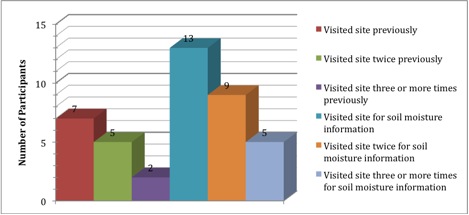 |
June 2010
|
June 2010 // Volume 48 // Number 3 // Tools of the Trade // v48-3tt6
Integrating the County Extension Web Site with On-Farm Data Collection
Abstract
Integrating the county Extension Web site with on-farm research can be an effective tool for the diffusion of information and technology. Using the county Extension Web site to relay information to on-farm research participants increases the participants' exposure to other information and programs available through the county Extension Web site.
Introduction
On-farm data collection has long been used as a tool for Extension research (Koenig, Winger, & Kitchen, 2000). Farmer participation has been established as an important aspect of this type of research (Wuest, McCool, Miller, & Veseth, 1999). Soil-moisture monitoring is an example of an effective on-farm research tool (Eldredge, Shock, & Stieber, 1993). Nahl (1998) found that information need influenced use of the Internet. Huberman, Pirolli, Pitkow, and Lukose (1998) suggested that visitors of Web sites tend to view additional pages. The study reported here explores using on-farm data collection research as a tool for encouraging farmers to access the county Extension Web site.
Methodology
In 2008, 16 sites in Utah's Garfield and Kane counties were equipped with soil-moisture monitoring equipment. Each site consisted of three granular matrix soil-moisture sensors. The sensors were placed at 1-foot, 2-foot and 4-foot depths. Each site was equipped with a data logger connected to the sensors. The data logger was set to record the soil-moisture readings at all three depths every 8 hours (Orloff, Hansen, & Putnam, 2003).
The most current soil-moisture reading was available to participants on demand via a small digital display integrated into the onsite data logger. This allowed farmers to make day-to-day irrigation management decisions based upon current soil-moisture levels. A history of all readings was recorded in the memory of the data logger. These records were retrieved from the data logger by attaching a notebook computer to the data logger and downloading the data to the hard drive.
The data was imported into an Excel file. Using Excel, the data was plotted onto a graph for visual analysis. The Excel graph was converted into a PDF document. The PDF document was then uploaded to the county Extension Web site.
A soil-moisture section was created under the agriculture link on the county Web site. The soil-moisture section of the Web site contained a reference page with detailed information about the soil-moisture monitoring program as well as a page where farmers could access their individual soil-moisture data using a personalized identification number. Bimonthly, data was retrieved from each site and uploaded to the county Extension Web site.
Participants were sent an email with a personal ID number and a link to the county Extension Web site home page. Detailed directions were provided to guide the participant from the home page to the individual soil-moisture data page. This approach provided participants with the opportunity to see other information available on the Web site and encouraged further discovery of what the Web site has to offer (Huberman et al., 1998).
Impacts
Thirteen of the 16 participants accessed their individual soil-moisture information on the county Extension Web site. Previously, only seven of these 13 participants had visited the Extension Web site. Before the soil-moisture information was posted on the Web site, only five of these 13 participants had visited the Extension Web site twice. After the soil-moisture information was posted to the Web site, nine of the 13 participants accessed the Web site at least twice. Before the soil-moisture information was posted on the Web site, only two of the 13 participants had visited the Web site three or more times. Afterward, five of the 13 participants accessed the Web site three or more times (Figure 1). All 13 participants who accessed their personal soil-moisture information viewed additional pages of the Extension Web site.
Figure 1.
Web Site Usage of Participants

We concluded that integrating the county Extension Web site with on-farm data collection was an effective process for introducing, reestablishing and retaining farmer interaction with the county Extension Web site. Furthermore, providing on-farm data on the county Extension Web site increased farmer exposure to other information provided by the Web site.
Discussion
A strong personal connection to the information was critical to farmer interaction with the county Web site. Although collecting individualized information has limitations, this type of tool is ideal for programs where individualized information is inherently necessary. Adding a Web site element to these programs can assist in the dissemination of information for other programs. Increasingly, user-friendly Web site tools have made this process more practical than ever.
References
Eldredge, E. P., Shock, C. C., & Stieber, T. D. (1993). Calibration of granular matrix sensors for irrigation management. Agronomy Journal, 85, 1228-1232.
Huberman, B. A., Pirolli, P. L. T., Pitkow, J. E., & Lukose, R. M. (1998). Strong regularities in World Wide Web surfing. Science, 280(5360), 95-97.
Koenig, R. T., Winger, M., & Kitchen, B. (2000). Simple, low cost data collection methods for agricultural field studys. Journal of Extension [On-line], 38(2) Article 2FEA1. Available at: http://www.joe.org/joe/2000april/a1.php
Nahl, D. (1998). Learning the internet and the structure of information behavior. Journal of the American Society for Information Science, 49(11), 1017-1023.
Orloff, S., Hanson, B., & Putnam, D. (2003). Utilizing soil-moisture monitoring to improve alfalfa and pasture irrigation management. Crop Management doi:10.1094/CM-2003-0120-01-MA. Retrieved June 18, 2010, from: http://www.plantmanagementnetwork.org/pub/cm/management/2003/moisture/
Wuest, S. B., McCool, D. K., Miller, B. C., & Veseth, R. J. (1999). Development of more effective conservation farming systems through participatory on-farm research. American Journal of Alternative Agriculture, 14(3), 98-102.




